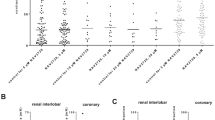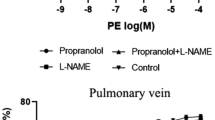Summary
Experiments were performed on the isolated, electrically driven guinea-pig heart, perfused at constant rate. All animals were pretreated with reserpine. Myocardial contractile force (MCF), coronary perfusion pressure (CPP) and myocardial oxygen consumption (QO2) were monitored continuously.
Both adenosine (ADO) and PGE2 produced a concentration-dependent decrease in the CPP. The ED50 (50% of maximum response) was 2.1±0.6×10−9 M for PGE2 but 40±7×10−9 M for ADO (P<0.01) at 1.8 mM Cae. This coronary vasodilation was independent of the external Ca-concentration, which was varied between 0.55–9.0 mM. PGE2 had no effect on MCF or QO2 and the effect of ADO was only slight. There was no evidence that any action of ADO could be inhibited by simultaneously applied PGE2.
The results provide evidence for the specific coronary vasodilating action of PGE2 which in this system is about 20 times as effective as adenosine.
Zusammenfassung
Es wird über Versuche an isolierten Meerschweinchenherzen berichtet, bei denen myodardiale Kontraktionskraft (MCF), koronarer Perfusionsdruck (CPP) und myokardialer Sauerstoffverbrauch (QO2) simultan und kontinuierlich gemessen wurden. Die Herzen wurden mit konstanter Frequenz (180/min) elektrisch gereizt und nachLangendorff volumenkonstant (10 ml/min) perfundiert. Alle Tiere waren mit Reserpin vorbehandelt.
Zusatz von Adenosin (ADO) oder PGE2 zur Perfusionslösung führte zu einer konzentrationsabhängigen Abnahme des CPP. Die ED50 (50% der maximalen Reaktion) betrug 2.1±0.6 nM für PGE2 und 40±7 nM für ADO (P<0.01) bei 1.8 mM Cae. Kumulative Erhöhung des Cae in 6 Stufen von 0.55 auf 9.0 mM beeinflußte die koronare Vasodilatation durch ADO oder PGE2 nicht. Die Koronardilatation kann auch nicht durch eine substanzspezifische Wirkung auf MCF oder QO2 erklärt werden, obwohl beide durch ADO bei hohem Cae vermindert waren (P<0.05). ADO-Effekte wurden durch gleichzeitig appliziertes PGE2 nicht gehemmt.
Die Ergebnisse sprechen für eine spezifische koronardilatierende Wirkung von PGE2. Die Substanz ist an diesem Modell etwa 20fach wirksamer als Adenosin.
Similar content being viewed by others
References
Berridge, M. J.: The interaction of cyclic nucleotides and calcium in the control of cellular activity, Adv. Cycl. Nucleot. Res.6, 1–85 (1975).
Bito, L. Z.: Accumulation and apparent active transport of prostaglandins by some rabbit tissues in vitro. J. Physiol. (Lond.)221, 371–387 (1972).
Buckley, N. M.: Cardiac effects of nucleosides after propranolol treatment of isolated hearts, Amer. J. Physiol.218, 1399–1405 (1970).
Bürger, R., F. J. Haddy, E. Gerlach: Coronary response to dilating substances and competitive inhibition by theophylline in the isolated perfused guinea pig heart, Pflüg. Arch. ges. Physiol.358, 213–224 (1975).
Hedqvist, P., A. Wennmalm: Comparison of the effects of prostaglandins E1, E2 and F2α on the sympathetically stimulated rabbit heart, Acta Physiol. Scand.83, 156–162 (1971).
Ishihara, T., M. Nozaki, Y. Maruyama, F. Takenaka: Effects of prostaglandin E1 on coronary circulation. Jap. J. Pharmacol.24, Suppl., 66 (1974).
Jacob, M. I., R. M. Berne: Metabolism of purine derivatives by the isolated cat heart, Amer. J. Physiol.,198, 322–326 (1960).
Klaus, W., R. Krebs: Eine verbesserte Methode zur gleichzeitigen Messung des Sauerstoffverbrauchs und der mechanischen Aktivität isolierter Muskel-Präparate. Naunyn-Schmiedeberg's Arch. Pharmacol.261, 93–101 (1968).
Krebs, R., K. Schrör: Actions of prostaglandin E2 on myocardial mechanics, coronary vascular resistance and oxygen consumption in the guinea pig isolated heart preparation. Brit. J. Pharmacol.55, 403–408 (1975).
Krebs, R., K. Schrör: Interactions of isopernaline and prostaglandin E2 with respect to myocardial contractile force, coronary vascular resistance and myocardial oxygen consumption in guinea pig isolated hearts, Brit. J. Pharmacol.57, 533–541 (1976).
Logan, M. E., V. T. Wiedmeyer: Changes in myocardial adenosine concentration during prostaglandin-induced coronary vasodilation. Fed. Proc.32, 787 (1973).
Malik, K. U.: Cardiovascular actions of prostaglandins. In: Prostaglandins: Physiological, Pharmacological and Pathological aspects, Ed. S. M. M. Karim, pp. 103–200 (Lancaster 1976).
Mentz, P., H. Opitz, W. Rettkowski, W. Förster: On the dependence of prostaglandin (PG) actions on calcium concentration in isolated heart preparations. J. Molec. Cell. Cardiol.9, Suppl., 29–30 (1977).
Needleman, P., M. S. Minkes, J. R. Douglas: Stimulation of prostaglandin biosynthesis by adenine nucleotides: profile of prostaglandin release by perfused organs. Circulat Res.34, 455–460 (1974).
Needleman, P., G. R. Marshall, B. E. Sobel: Hormone interactions in the isolated rabbit heart. Synthesis and coronary vasomotor effects of prostaglandins, angiotensin and bradykinin. Circulat. Res.37, 802–808 (1975).
Nutter, D. O., H. J. Crumly Jr: Canine coronary vascular and cardiac responses to the prostaglandins. Cardiovasc. Res.6, 217–225 (1972).
Ogletree, M. L., A. C. Beardsley, A. M. Lefer: Myocardial actions of prostaglandins in isolated cat cardiac tissue. Life Sci.16, 1923–1930 (1975).
Raff, W. K., F. Kosche, H. Goebel, W. Lochner: Die extravasculäre Komponente des coronaren Widerstandes mit steigendem linksventrikulärem Druck. Pflüg. Arch. ges. Physiol.333, 352–361 (1972).
Rowe, G. G., S. Alfonso: Systemic and coronary hemodynamic effects of intracoronary administration of prostaglandins E1 and E2. Amer. Heart J.88, 51–60 (1974).
Rubio, R., R. M. Berne: Release of adenosine by the normal myocardium in dogs and its relationship to the regulation of coronary resistance. Circulat. Res.25, 407–415 (1969).
Schrör, K., R. Krebs: On the action of PGE2 on coronary vessels. A comparative study with adenosine. Naunyn-Schmiedeberg's Arch. Pharmacol.293, Suppl., R 27 (1976).
Schrör, K., R. Krebs, Ch. Nookhwun Increase the coronary vascular resistance by indomethacin in the isolated guinea pig heart preparation in the absence of changes in mechanical performance and oxygen consumption. Europ. J. Pharmacol.39, 161–169 (1976).
Stjärne, L.: Inhibitory effect of prostaglandin E2 on noradrenaline secretion from sympathetic nerves as a function of external calcium, Prostaglandins3, 105–109 (1973).
Van der Veen, K. J., A. F. Willebrands: Effects of frequency and Ca++ concentration on oxygen consumption of the isolated rat heart. Amer. J. Physiol212, 1536–1539 (1967).
Weissel, M., G. Brugger, G. Raberger, O. Kraupp: The effects of adenosine on coronary conductance, cardiac dynamics and myocardial metabolism of the isolated perfused cat heart. Pharmacology12, 120–128 (1974).
Author information
Authors and Affiliations
Additional information
With 5 figures and 2 tables
Supported by the Deutsche Forschungsgemeinschaft
Some of these results were presented to the Spring meeting of the Deutsche Pharmakologische Gesellschaft, Mainz, 23–26 March (1976)
Ch. N. is a DAAD stipendiate from Bangkok (Thailand)
Rights and permissions
About this article
Cite this article
Schrör, K., Berg-Becker, M. & Nookhwun, C. The specificity of prostaglandin E2 (PGE2) in reducing coronary vascular resistance: A comparison with adenosine. Basic Res Cardiol 73, 287–297 (1978). https://doi.org/10.1007/BF01906734
Received:
Issue Date:
DOI: https://doi.org/10.1007/BF01906734




